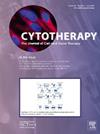Quantitative Predictive Cellular Analytics Driving Improvements in Advanced Therapy Development and Manufacturing
IF 3.7
3区 医学
Q2 BIOTECHNOLOGY & APPLIED MICROBIOLOGY
引用次数: 0
Abstract
Background & Aim
Advanced therapy medicinal products (ATMPs) such as chimeric antigen receptor (CAR) T-cell therapies have shown great success, but challenges remain. These include variability in patient and donor cell quality and complex manufacturing processes, highlighting the need for robust analytical methods to ensure quality and consistency while increasing access. Process automation offers benefits, but fit-for-purpose cell-based analytics are crucial for providing predictive and prescriptive insights from R&D through manufacturing and quality control (QC). Connecting analytics throughout the development and manufacturing process can reduce the need for comparability studies, lower costs, and improve product quality. This study provides data supporting Laser Force Cytology (LFC) as a comprehensive cell-based analytical tool for use throughout the entire CAR T-cell development process, including donor screening, process development, monitoring, and QC.
Methodology
LumaCyte's Radiance® instrument uses LFC, combining optical and hydrodynamic force measurements to analyze single cells without the need for antibodies or fluorescent labels. To demonstrate the technology, naive, mock transduced, and CD19+ CAR T cells were manufactured from healthy human donors. Transduced cells were incubated with NALM6 cells for a 24h period at different effector:target cell ratios. After the 24h incubation period, co-cultures and monocultures were analyzed using LFC and in parallel monitored for luciferase activity, which served as an orthogonal measurement of the NALM6 cell killing.
Results
Co-culture assay results demonstrated a strong correlation between the killing efficacy measured using the label-free LFC data with the orthogonal luciferase assay. After establishing the co-culture killing capacity of each manufactured CAR T cell lot, donors were classified as either high or low-killing efficiency. Using the LFC analysis of the PBMC starting materials from each donor, the classification as either high or low-killing efficiency could be predicted.
Conclusion
LFC precisely measures subtle cellular changes, providing near real-time data that enables donor and process prediction to speed process development and ultimately improve manufacturing and clinical outcomes. Our data demonstrate how this novel technology improves CGT development and production assays, compress development time, and reduces costs for these life-saving treatments.
定量预测细胞分析推动先进疗法开发和制造的改进
背景,嵌合抗原受体(CAR) t细胞疗法等先进治疗药物(ATMPs)已经取得了巨大的成功,但挑战依然存在。其中包括患者和供体细胞质量的可变性以及复杂的制造过程,突出表明需要强大的分析方法来确保质量和一致性,同时增加可及性。过程自动化带来了好处,但是基于单元的分析对于从研发到制造和质量控制(QC)提供预测性和规范性的见解至关重要。在整个开发和制造过程中连接分析可以减少对可比性研究的需求,降低成本并提高产品质量。本研究提供的数据支持激光力细胞学(LFC)作为一种全面的基于细胞的分析工具,用于整个CAR - t细胞发育过程,包括供体筛选、工艺开发、监测和质量控制。umacyte的Radiance®仪器使用LFC,结合光学和流体动力测量来分析单个细胞,而不需要抗体或荧光标记。为了证明这项技术,我们从健康的人类供体中制造了原始的、模拟的、CD19+的CAR - T细胞。转导后的细胞与NALM6细胞以不同的效应器和靶细胞比例孵育24小时。24小时孵育后,用LFC分析共培养和单培养,并平行监测荧光素酶活性,作为NALM6细胞杀伤的正交测量。结果培养实验结果表明,无标记LFC数据与正交荧光素酶法测定的杀虫效果有很强的相关性。在确定每个制造的CAR - T细胞批次的共培养杀伤能力后,将供体分为高杀伤效率和低杀伤效率两类。通过对各供体PBMC起始材料的LFC分析,可以预测其杀灭效率的高低。lfc精确测量细微的细胞变化,提供接近实时的数据,使供体和工艺预测能够加快工艺开发,最终改善制造和临床结果。我们的数据表明,这项新技术如何改善CGT开发和生产分析,缩短开发时间,并降低这些挽救生命的治疗成本。
本文章由计算机程序翻译,如有差异,请以英文原文为准。
求助全文
约1分钟内获得全文
求助全文
来源期刊

Cytotherapy
医学-生物工程与应用微生物
CiteScore
6.30
自引率
4.40%
发文量
683
审稿时长
49 days
期刊介绍:
The journal brings readers the latest developments in the fast moving field of cellular therapy in man. This includes cell therapy for cancer, immune disorders, inherited diseases, tissue repair and regenerative medicine. The journal covers the science, translational development and treatment with variety of cell types including hematopoietic stem cells, immune cells (dendritic cells, NK, cells, T cells, antigen presenting cells) mesenchymal stromal cells, adipose cells, nerve, muscle, vascular and endothelial cells, and induced pluripotential stem cells. We also welcome manuscripts on subcellular derivatives such as exosomes. A specific focus is on translational research that brings cell therapy to the clinic. Cytotherapy publishes original papers, reviews, position papers editorials, commentaries and letters to the editor. We welcome "Protocols in Cytotherapy" bringing standard operating procedure for production specific cell types for clinical use within the reach of the readership.
 求助内容:
求助内容: 应助结果提醒方式:
应助结果提醒方式:


